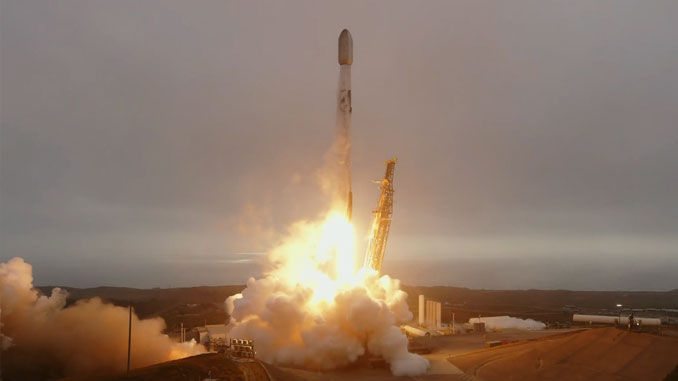SpaceX has once again pushed the boundaries of satellite technology and global connectivity. On Thursday night, Elon Musk’s aerospace company successfully launched 26 new Starlink V2 Mini satellites into low Earth orbit (LEO). The mission, dubbed Starlink 15-6, lifted off aboard a Falcon 9 rocket from Vandenberg Space Force Base at 10:26 PM local time.
The launch marks another milestone in SpaceX’s ambitious goal of creating a robust global broadband network, especially aimed at providing internet access in remote and underserved regions.
Falcon 9 Delivers Once Again
The Falcon 9 rocket, known for its reusable first stage, executed a flawless liftoff under clear California skies. Within minutes, the first stage separated and returned to Earth, landing precisely on the drone ship “Of Course I Still Love You” stationed in the Pacific Ocean.
This marked the 18th successful flight for this particular Falcon 9 booster, further solidifying SpaceX’s record-breaking progress in reusable rocket technology. The upper stage then continued its trajectory, deploying the 26 Starlink satellites into their designated orbits.
What Are Starlink V2 Mini Satellites?
These newly launched Starlink V2 Mini satellites represent a technological leap forward. Compared to previous versions, the V2 Minis offer enhanced bandwidth, improved power efficiency, and better beamforming capabilities. Each satellite is designed to provide faster, more reliable internet services across vast geographic regions.
More importantly, they support direct-to-cell technology, meaning users may soon be able to connect to the Starlink network using just a smartphone—no dish required. This innovation could prove to be a game-changer for remote communication in isolated regions.
Global Internet Goals in Motion
With this launch, SpaceX now has over 6,500 active Starlink satellites in orbit. The company plans to eventually operate more than 12,000 satellites as part of its first-generation constellation, with proposals submitted for up to 42,000 satellites in the long term.
The Starlink network is already operational in more than 70 countries and has revolutionized internet access for consumers, businesses, airlines, ships, and even disaster zones. From the Amazon rainforest to the Himalayas, Starlink is bridging the digital divide.
Economic and Technological Impact
SpaceX’s Starlink program is not just about internet access; it’s also an economic driver. The satellite internet industry is expected to be worth $100 billion by 2030. By launching thousands of high-capacity satellites, SpaceX is positioning itself as a global leader in telecommunications infrastructure.
Moreover, countries investing in space-based internet are likely to see increased opportunities in education, e-commerce, healthcare, and defense. Starlink’s low latency and high speeds make it ideal for modern cloud computing, video conferencing, and remote work.
Elon Musk’s Vision for the Future
Elon Musk has repeatedly emphasized that Starlink is key to SpaceX’s broader mission. The revenue generated from satellite internet services helps fund future missions to the Moon and Mars. Musk aims to make humanity a multiplanetary species, and every satellite launched today is a step toward that future.
In a recent tweet following the launch, Musk said, “Another step toward global connectivity. Starlink will help everyone, everywhere.”
What’s Next for Starlink?
With the increasing pace of launches—often several per month—SpaceX is accelerating its deployment strategy. The company is also testing laser inter-satellite links, allowing satellites to communicate directly without routing signals through Earth stations, reducing latency even further.
By the end of 2025, SpaceX expects to launch hundreds more satellites and offer global mobile coverage. Customers in rural Pakistan, Africa, and Southeast Asia are already seeing improvements in connectivity.
Read More: Punjab Cabinet Approves Historic Rs. 5,335 Billion Budget
The successful launch of 26 new Starlink satellites underscores SpaceX’s commitment to creating a connected planet. With its cutting-edge Falcon 9 rocket, visionary leadership from Elon Musk, and relentless innovation, the company is transforming how the world accesses the internet.
As SpaceX continues to push forward, the dream of affordable, high-speed internet for all is becoming a reality—one satellite at a time.
Read More: BlackBerry Passport SE Pro Makes a Bold Comeback in 2025









